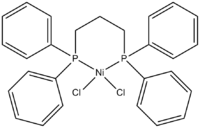- Dichloro(1,3-bis(diphenylphosphino)propane)nickel
-
Dichloro(1,3-bis(diphenylphosphino)propane)nickel  Other names1,3-bis(diphenylphosphino)propanenickel(II) chloride
Other names1,3-bis(diphenylphosphino)propanenickel(II) chlorideIdentifiers CAS number 15629-92-2 Properties Molecular formula C27H26Cl2NiP2 Molar mass 542.04 g mol−1 Appearance Orange to yellow orange powder Melting point 213 °C, 486 K, 415 °F
Solubility in water immiscible in water Hazards MSDS [1] R-phrases R49-36/37/38-42/43 S-phrases S53-26-36/37/39-45  (verify) (what is:
(verify) (what is:  /
/ ?)
?)
Except where noted otherwise, data are given for materials in their standard state (at 25 °C, 100 kPa)Infobox references Dichloro[1,3-bis(diphenylphosphino)propane]nickel a coordination complex with the formula NiCl2(dppp) (where dppp = Ph2PCH2CH2CH2PPh2). It is used as a catalyst in organic synthesis. The compound is an orange crystalline powder.
Contents
Structure and properties
The compound exhibits C2v symmetry with square planar geometry at the central nickel atom. The compound is soluble in non-polar organic solvents and is diamagnetic.
Preparation
NiCl2(dppp) is prepared by combining equal molar portions of nickel(II) chloride hexahydrate with 1,3-bis(diphenylphosphino)propane in 2-propanol.[1]
- Ni(H2O)6Cl2 + dppp → NiCl2(dppp) + 6 H2O
Reactions
It is used in Grignard reagent reactions involving cross-coupling of aryl halides, converting enol ethers, dithioacetals, and vinyl sulfides to olefins. NiCl2(dppp) is used because the douple phosphate ligand minimizes the reduction reactions with labile β-hydrogens.[2]
Cross-coupling reactions of R-X compounds with organometallic nucleophiles are catalyzed by transition metal complexes such as NiCl2(dppp). The R group consists of aryl, vinyl, or allyl groups and the X group is a good leaving group. Cross-coupling reactions are effective at producing carbon-carbon bonds. Catalysts that have bidentate phosphine ligands serve as the best catalysts.[3]
NiCl2(dppp) serves as the catalyst by bonding the two cross-coupling components to the nickel. The cross-coupling proceeds by oxidative addition of the aryl, vinyl, or allyl halide to NiCl2(dppp) forming an oxidative addition adduct, R1-NiCl(dppp). The organometallic nucleophile, R2-MgBr, reacts with R1-NiCl(dppp) and is followed by the cross-coupling reaction producing the R1-R2 product.[4]
The compound is a catalyst for Kumada coupling reactions involving alkyl, alkenyl, aryl, and heteroaryl Grignard reagents with aryl, heteroaryl, and alkenyl halides.[1]
References
- ^ a b Kumada, Makota; Tamao, Kohei; Sumitani, Koji (1988), "Phosphine-Nickel Complex Catalyzed Cross-Coupling of Grignard Reagents with Aryl and Alkenyl Halides: 1,2-dibutylbenzene", Org. Synth., http://www.orgsyn.org/orgsyn/orgsyn/prepContent.asp?prep=cv6p0407; Coll. Vol. 6: 407
- ^ Sigma-Aldrich. CAS 15629-92-2.
- ^ Tien-Yau Luh; Tien-Min Yuan. ”Cross-Coupling Reactions”. Encyclopedia of Reagents for Organic Synthesis. DOI: 10.1002/047084289X.rd100.pub2.
- ^ Ljungdahl, Thomas; Bennur, Timmanna; Dallas, Andrea; Emtenaes, Hans; Maartensson, Jerker (2008). "Two Competing Mechanisms for the Copper-Free Sonogashira Cross-Coupling Reaction". Organometallics 27 (11): 2490–2498. doi:10.1021/om800251s.
Categories:- Nickel compounds
- Phosphine complexes
Wikimedia Foundation. 2010.
